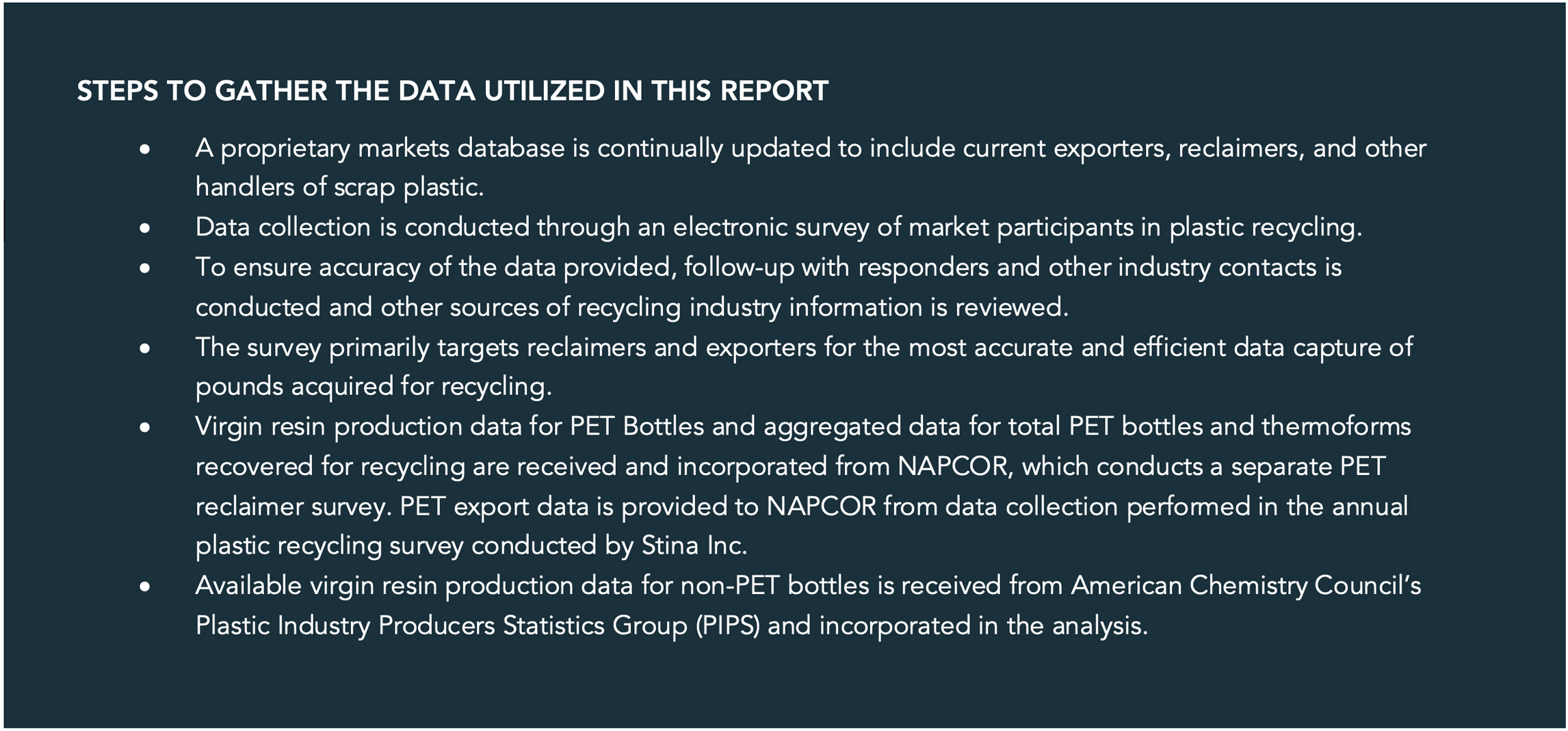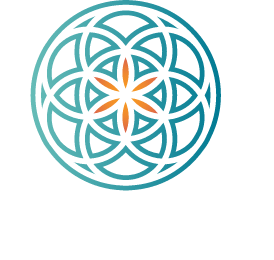Home
Introduction
Pounds Recovered
By Destination
% of Total Recovered
Data Gaps & Assumptions > < Table of Contents
METHODOLOGY
Data on post-consumer plastic recovered for recycling are collected through a voluntary, annual plastic recycling survey that gathers data on post-consumer bottles, non-bottle rigid plastics, film and other plastics acquired by North American reclaimers and overseas export markets. Additional data from collaborators also contribute to the findings for this report.

Data Collection and Analysis Stina regularly updates a proprietary database of plastic reclaimers, other processors, exporters, and brokers to help ensure that the survey reaches the key plastic scrap buyers of North American plastic.14 Stina focuses survey follow up for data capture based on the scope of the current year study. Stina uses a custom-designed, secure web-based survey system to gather data. Although the overall methodology has not changed since the first study, Stina seeks ways to improve the completeness and timeliness of survey responses with each iteration to allow for better material flow tracking and assist with prevention of double counting. Stina is involved in the plastic recycling industry's work to harmonize commodity categories and the terminology used by the industry. Updates to categories are reflected in the annual survey tool and in the other tools and resources for the recycling industry that Stina maintains. This is critical in order to report on the key materials, to avoid misunderstanding, and to further support harmonization of terminology used in the industry. The model plastic bale specifications, maintained by the Association of Plastic Recyclers (APR) and updated in collaboration with Institute of Scrap Recycling Industries (ISRI), are a key resource in this process. 15 A list of survey categories can be viewed below:
Survey Categories
The survey is distributed by sending an email with a unique link to each survey contact, including reclaimers in North America, export buyers, as well as some key players within the value chain, such as MRFs, brokers, and end users. After an appropriate amount of response time has passed, follow-up emails and telephone calls are made to retrieve data. The data are entered into the online survey tool, either directly by the company surveyed, or by Stina staff in conjunction with the relevant company. Incoming data are reviewed for accuracy, and follow-up calls are made as needed. After data collection is complete, the data are compiled and cateorized based on the detail reported. 16 Rigid commodity categories from commingled/other collection, typically collected curbside or at a municipal drop-off, may be a mixture of resins, or some combination of bottles, containers, bulky items, and other non-bottle rigid plastic. Some commodity categories are further separated by resin and others are intentionally reported as a combination of resin and product type. Where bale audit data exists, it is applied to commodities reported by respondents to breakout by resin and by bottle and non-bottle rigid plastic portions to include those quantities in the totals. The most recent National Rigid Bale Composition Study was conducted in 2022, updating data for the most common mixed rigid bales (e.g., PP Small Rigid and Mixed Bulky Rigid). The 2022 Study also looked at HDPE bottle bales for the first time and that data was applied to the HDPE bottle commodities. This allowed for an allocation of natural and color HDPE bottles within the commodities, as well as helped to capture the other plastics found in these commodities, (e.g., non-bottle HDPE and PP).17 Data received from NAPCOR and PIPS are incorporated into the analysis. The final data totals are reviewed, analyzed, and reported in as much detail as possible without compromising the confidentiality of the participating companies' individual responses. In order to determine trends and identify anomalies that may require further vetting, the analysis includes year-to-year comparisons of the totals, material categories, and trends among buyers. This quality control, which often requires follow-up with survey responders, is essential to determining if there has been an actual shift or just an entry error by the responder. Clarification may also be needed to determine whether reported material can be counted as post-consumer/commercial or if it is, in fact, post-industrial scrap. Describing how the data are collected, as well as what is and is not included in the survey, provides readers of this report with the transparency needed to cross-reference the results with other available industry data.
Data Gaps and Assumptions > < Methodology
14. Through other research projects and resources that Stina maintains to support the recycling value chain, Stina regularly engages with companies and new contacts in this sector. 15. Bale specifications maintained by the Association of Plastic Recyclers (APR), https://plasticsrecycling.org/model-bale-specifications. 16. Due to rounding, some totals may not correspond with the sum of the separate figures. 17. From 2016 to 2021, the 2014/2015 Mixed Rigid Bale Composition Study data with some adjustment given interim sorts and industry provided audit data was used for the reports whereas previous reports dating back to 2011 used the 2011 composition study. National Mixed Rigid Plastic Bale Composition Study, Association of Plastic Recyclers (APR), July 2015 and 2011. A couple less traded commodities still utilize previous year bale audit data. 18. Stina conducts the survey and takes steps to maintain the confidentiality of individual responses; including procedures designed so that no individual company data are released, nor are any specific data points that do not include at least three companies reporting.
Powered and managed by

 © 2024 Stina Inc. All Rights Reserved
Terms & Conditions
Privacy Policy
© 2024 Stina Inc. All Rights Reserved
Terms & Conditions
Privacy Policy
Powered and managed by

 © 2024 Stina Inc. All Rights Reserved
Terms & Conditions
Privacy Policy
© 2024 Stina Inc. All Rights Reserved
Terms & Conditions
Privacy Policy
